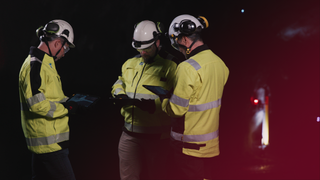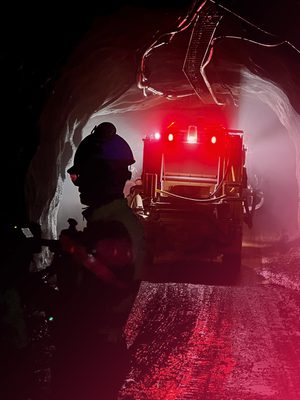How Normet are driving safer, smarter mining with automation at Callio FutureMINE
As mining operations push deeper underground, the technical challenges - and risks - intensify. To meet these demands, the industry is turning to automation and tele-remote technologies that allow machinery and autonomous vehicles to be operated from the surface. This shift not only enhances worker safety by removing personnel from hazardous environments but also boosts productivity by minimising downtime and maximising equipment utilisation.
At the forefront of this transformation is Normet, a world-leading mining technology manufacturer, currently testing autonomous vehicles at Callio FutureMINE. In this Q&A, Mark Ryan, Normet’s VP of Equipment Offering & New Technology, shares insights from Normet’s testing at Callio FutureMINE, exploring the technologies, challenges, and connectivity requirements shaping the next generation of mining.
What technologies are you testing at Callio FutureMINE?
At Callio FutureMINE, we’re doing a lot of testing around automation - in other words, taking people out of harm’s way. Underground mining and tunnelling are quite hazardous, so the idea here is to be able to take people out of that hazardous zone. A lot of testing, a lot of proof of concept, and a lot of proving that the technology is reliable and safe is being done at the Callio mine.
What benefits will this technology bring for the whole mining industry?
I think the main benefit of autonomous vehicles is being able to get people away from those dangerous environments and, at the same time, increase productivity and utilisation of assets. The technical challenge of mining and tunnelling is getting harder and harder. Our customers are having to go deeper than ever before, and creating an environment that is safe for people to exist in is becoming more difficult. So being able to take those people out of those environments, put them into a safe location, and still utilise and carry out the same operations as before is really where the main advantages lie.
What are the connectivity requirements to drive these applications and use cases?
The requirements are really to have private 5G networks underground, particularly ones dedicated to the actual processes. Trying to utilise open Wi-Fi and similar technologies tends not to work - you often encounter problems with latency and performance. So having these dedicated networks underground is key to the technology being successful.
What are the problems you're trying to solve with automation?
Nowadays, the easily mineable resources have already been depleted, so mining companies are having to go deeper and deeper underground to extract these precious minerals. With that comes incredible technical challenges - mainly related to heat and being able to remove that heat from the mine to make the environment comfortable for people. Because the technical challenge is becoming more and more difficult, one solution is to remove people completely from the process: put them in an environment, for instance on the surface, where they can work in a controlled setting. Then, through high-speed 5G networks, they can control the machines remotely.
What does a fully automated future look like?
What it looks like is that 90% of the people who are currently underground will be doing something on the surface. So we will be heavily reducing the need for people to be underground. There will still be people needed underground to set up and to handle exceptional cases where something needs to be done with a piece of equipment or a process. But in general, the idea is that the equipment would be set up and then operated from the surface. Ultimately, the need to have people in those dangerous environments would be eliminated.
Why did you choose to test these technologies at Callio FutureMINE?
Callio was once a deep-working mine, so we have the opportunity to test equipment in real environments. Callio is really good at setting up conditions that allow you to simulate real processes, whether it’s spraying concrete or scaling. They’re able to create those environments for us - real environments. I think being able to test products in a real environment is what truly brings value to our work with Callio.
The private 5G network at Callio has been excellent. We’ve worked with different networks and technologies over the years, but this 5G network is outstanding. It provides everything we need to perform live testing. We’re able to capture data in real time, and the lack of latency has been very impressive.
I think the private network and how it’s performed has been fantastic. Quite often with open-source networks, there are certain times of the day when performance drops because of the number of people on the network. So having a dedicated network for these kinds of processes and operations is a must. The performance has been exceptional.

